We all need magic in our lives, and we all need more nutrition. I satisfy both needs by combining food preparation and alchemy, and tinctures are a fun way to do this really easily.
I decided to give tinctures a try after reading a blog post by my awesome friend Kristen Suzanne. You can read Part I here and Part II here. Because my kitchen is overflowing with various herbs (I make a lot of infusions), I picked the one herb I had that would best support me in my 3rd trimester of pregnancy. Introducing… The mighty raspberry leaf.

Pregnant or not, if you are a woman, you can benefit from consuming raspberry leaf in various concoctions.
Benefits of Raspberry Leaf
– Increased nutrition, thanks to the high mineral content (iron, magnesium, B vitamins, and more),
– Pregnancy support, by making the uterus stronger, and helping bring it back to its original size postpartum,
– Some evidence of easier, shorter labor (of course, other variables will influence how easy labor will be for you)
– Easier, less painful menstrual cycles
– Skin soothing benefits, when applied locally
– Measurable antioxidant activity
– Treatment of stomach disorders, such as diarrhea
– Immune support for various ailments including respiratory disorders and heart problems
– Blood sugar regulations in diabetic patients
… and more. Of course, nothing in itself is a cure. Raspberry leaf is only one piece of the puzzle! Always consult your preferred health care provider with questions relating to your specific situation.
Now, why did I make a tincture out of the raspberry leaf? I like to use raspberry leaf for infusions as well, but I wanted something a little different. With an infusion, you steep the leaves in hot water to extract beneficial compounds. With a tincture, you first moisten the leaves with hot water, but you also soak them in alcohol for over a month, extracting even more benefits.
Benefits of herbal tinctures
– Alcohol is a wonderful medium to extract many of the beneficial compounds found in herbs. Just eating the herb often doesn’t cut it. Our digestive system isn’t designed to extract many of the components (ruminants have several stomachs, whereas we have only one, for instance), and sometimes something other than heat is needed. Tinctures fill the gap.
– Tinctures can be taken quickly. Just a half teaspoon gives you a ton of the concentrated benefits of whatever herb you’re using. With an infusion, you need to steep the herbs, let them cool, etc. Then, you need a drink a fairly big quantity of tea. Honestly, while I did that all the time when I wasn’t yet a mom, I wasn’t as diligent as the mother of toddler, or a pregnant mom. I still do infusions often, but not daily. Sometimes I feel too rushed, and sometimes I plain forget.
– Alcohol based tinctures have a very long shelf life. I’m sure you can keep them for a few years, and they’ll be just as potent as the first time you harvested them. Alcohol is a wonderful preservative. Your infusion, on the other hand, needs to be consumed the same day, or refrigerated, otherwise mold will develop and bacterial contamination may happen.
– With pills, you don’t really know what you’re getting. They’re usually full of fillers and additives. With tinctures, you’re getting the herb and the carrier, alcohol. That’s it.
Selecting your herbs
I only use organic herbs for tinctures, or herbs I would wild harvest from pristine areas. For the raspberry leaf tincture, I used these herbs from Mountain Rose Herbs. Everything they sell is organic and of very high quality. I love them. They’re also very inexpensive, which doesn’t hurt.
Selecting your glassware, utensils, and cleanser
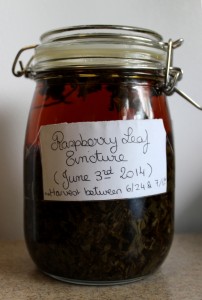
Steeping raspberry leaves with name and date of harvest on label
For steeping the herbs, I used a regular mason jar. I like flip-top jars (I got mine from Ikea) and mine look exactly like these. They seal well, so you won’t leak any tincture when you shake them. I also use good old Mason jars, and they work just fine too (but might leak a little with the plastic lid).
For straining, I used my favorite Bodum tea press. I have had mine for over 10 years and it’s as awesome as ever. I really don’t like the mess of using a mesh strainer, so I use this. I pour the finished tincture with the herbs in the center compartment, squeeze out the liquid with the top portion, and use the teapot itself to pour into small bottles. No mess. Then, I empty the herbs into the compost. It’s really easy.
For bottling, I used these really cute amber glass dropper bottles (the dropper is also glass, not plastic). They are shipped packed in bubble wrap, which was nice, because some other sellers will ship them in flimsy envelopes and you’ll get a few broken ones every time.
And finally, for cleaning, I took a tip from my husband. I didn’t want to use soap, because I wanted the bottles well sterilized. Instead, I filled a saucepan with warm water and added a little One Step cleanser. It’s a product widely used in homebrewing (my husband makes his own beer) and it’s so safe people will use it to sanitize their bottles before filling them with beer – no rinsing required. I soaked my bottles, then rinsed them, and set them on a towel to dry overnight. I squeezed some of the sanitizing water in the dropper bottles, then squeezed it out, and squeezed in some clean water to rinse. I set them to dry with the bottles.
So how do I make a tincture?
OK! So now, how do you actually make a raspberry leaf tincture? It’s easy. You take a quart jar. You add 2 cups of herbs (halfway) and pour enough boiled water on top of the herbs to moisten. Don’t drench them, just moisten them. Then, pour enough vodka on top to fill the entire jar. Close tightly. Set in a dark place for 4 weeks to steep, shaking the jar several times a week. I have my jars on the fridge, where I can remember to shake them. That’s it! After 4 to 6 weeks, strain the liquid out, bottle, label your jars, and you’re done.
That’s all there is to it. Making a tincture takes very little time, and it’s a fairly inexpensive way to get a lot of nutrition easily into your diet. I am currently making other tinctures, including reishi and oatstraw. I’ll blog about them when they’re ready to harvest! I also plan to make an immune support tincture to ensure I stay healthy during the winter months while my second child is still a baby.
Join Joanna Steven and Bethanne Wanamaker on our Remineralize Your Body program to remineralize yourself and restore your energy, hormonal balance, and natural beauty! Learn all about juicing, blending, seaweeds, cultured drinks and fermented vegetables, phytic acid breakdown and nutrient activation, and much more, along with daily coaching with our remineralization team! – See more at http://ediblegoddess.com/programs/remineralize-your-body-now/
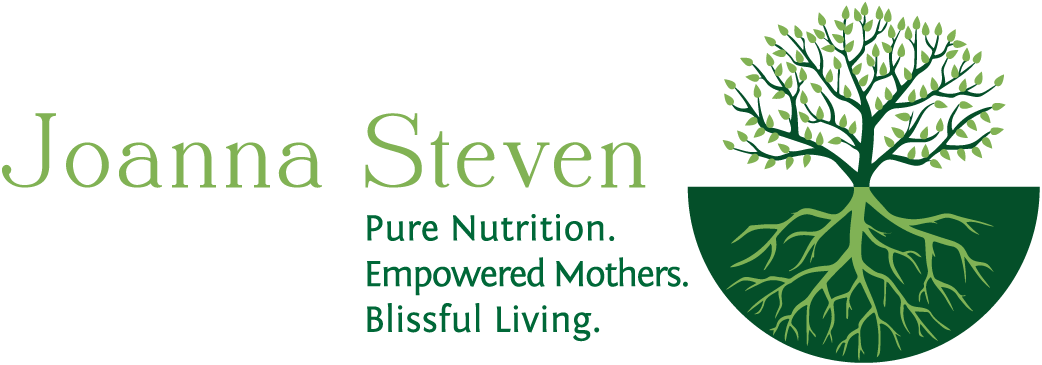
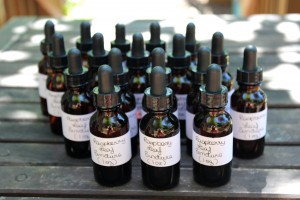
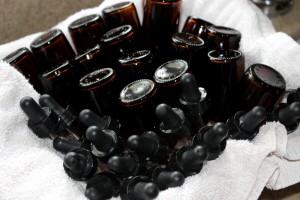
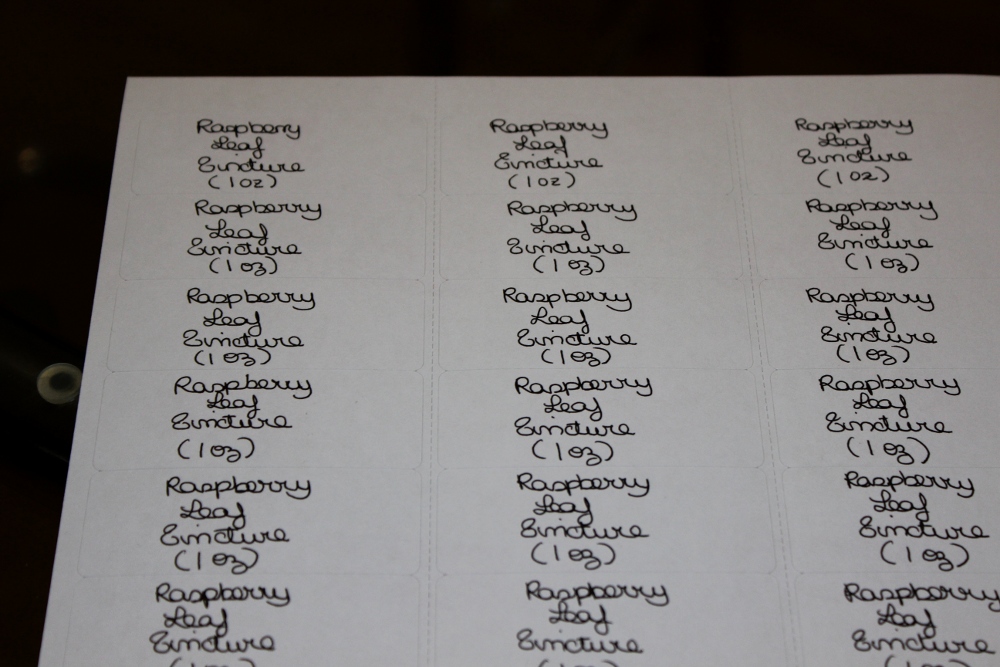
Pingback: Raspberry Leaf Tea To Cause LaborRaspberry Leaf Tea™ | Raspberry Leaf Tea™
If you dont like the tatse of raspberry tincture, what ia the best way to consume it?
Tinctures are gross 🙂
Either down a squirt with water or juice, or add a little to tea, or add to a smoothie 🙂
Is the half teaspoon you mentioned the suggested dosage? Any idea how that compares to a quart jar infusion? Thanks!
What Is stronger ? raspberry tincture or raspberry pills ? I’m thinking of ordering the tincture from vitamin shoppe
Hi I was wondering if you knew how red raspberry can be applied directly to the skin? Can I infused it in olive or coconut oil? Or no
You can chop it fine and cover the leaves with your oil of choice. Leave it to a steep for a couple weeks. That’s it 🙂
You have some beautiful information here, and I love the supportive community you have created here. I am a traditional herbalist who has upgraded her knowledge into that of a clinical medical practice. I am a clinical herbalist in Canada and think the content here is great, but have some recommendations.
I would not recommend steeping raspberry leaf in oil as it doesn’t extract the phytochemicals properly. Instead a vinegar is ideal – internal use obviously. For those looking to use it topically it is best to make a strong decoction or infusion and use it as a diluted wash. It has been traditionally used in syrups, teas and vinegars for medicinal treatments both internally and topically. Traditionally used as syrups and vinegars for digestive, circulatory and respiratory complaints, teas and tinctures as uterine tonics.
In terms of duration of “steeping” tinctures, it is best to only macerate herbs in alcohol for up to 2 days. It has been studied and proven that after this time the plant matter actually begins to reabsorb its phytochemicals leaving your tincture less potent and effective. I learned this myself by testing batches macerated for longer periods of time, and found great benefit to a shorter maceration. One can also make a tincture in a single day by pressing the tincture 3 times after macerating for 10-20min intervals.
Importantly…Why are you not labeling your tincture bottles with the ratio plant to menstrum, and do not include the alcohol percentage? All tincture bottles should be labeled with the latin plant name, date, ratio of alcohol to plant if using dried herbs. If making a fresh folk tincture the label should contain the plant name, “fresh folk” on the label as well, and the date it was prepared not harvested. When preparing a fresh tincture leaves should be dried for up to 2 days to ensure most of the water has been removed. You also need to powder herbs for tincture making. If fresh it is ideal to make in a blender and cover the herbs with enough alcohol to just cover and then blend.
Leaves should be used either fresh or well dried as there is some toxicity that occurs during the drying process.
It’s actually pretty important to know what constituents you want to extract from a plant as well. This directly impacts the alcohol percentage. So, if you are wanting to extract saponins let’s say, a 40% alcohol is sufficient as it has a higher water ratio which saponins need in order to extract. Flavonoids do well in a 40% or 60% alcohol. Raspberry is high in flavonoids 🙂
Folk medicine is beautiful, I work heavily with it in my practice, but feel pretty strongly about people sharing information about medicine making without giving proper advice. If you are selling your tinctures, proper labeling is important.